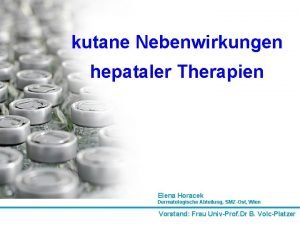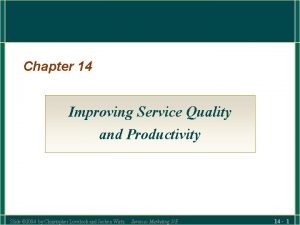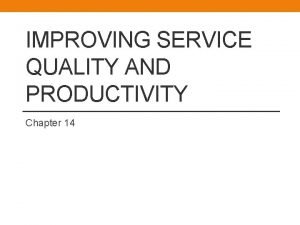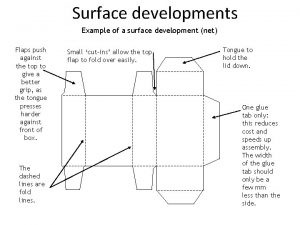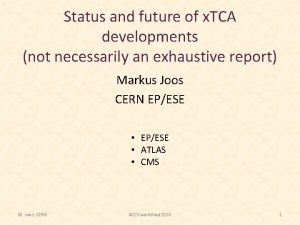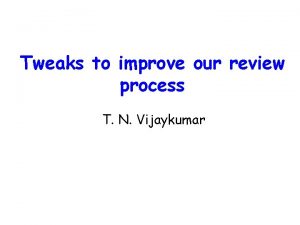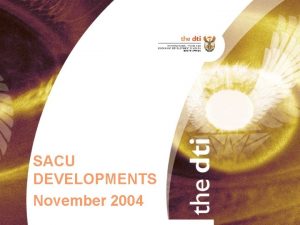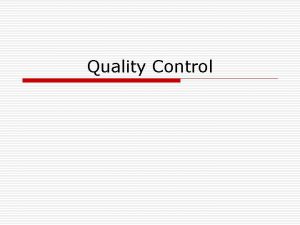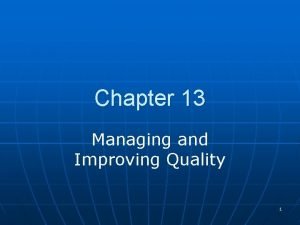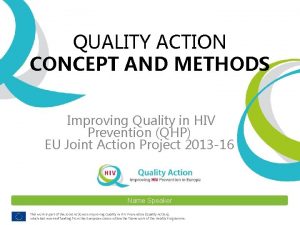Tweaks and Fixes New Developments in Improving Quality




























- Slides: 28

Tweaks and Fixes: New Developments in Improving Quality and Managing Problems Alan Marks Scott Laboratories Ltd.

Acknowledgements • Lallemand www. lallemand. com • Dominique Delteil, Lallemand Consultant & former director of the ICV (Institut Cooperératif du Vin) www. icv. fr

Defining Grape Quality Varietal aroma/flavour ◦ herbal, green >>>> jammy Skin tannin quality ◦ harsh, astringent >>>>>soft, supple Seed tannin development Brix, total acidity, p. H Fruit condition and berry size

Defining Wine Quality Clean, complex aromas & flavours Fullness & concentrated flavours Balance of acid/alcohol/residual sweetness Refinement, lack of harshness, astringency or bitterness Colour quality (intensity & hue) in reds Long finish

Ten Winemaking Commandments 1. Thou shalt not use DAP 2. Thou shalt press thy whites gently 3. Thou shall use fermentation tannins for reds 4. Thou shall use rehydration nutrients 5. Thou shall use only organic yeast nutrients 6. Thou shall not add SO 2 to an active ferment 7. Thou shalt not ferment reds above 25 C 8. Thou shall use co-inoculation for MLF 9. Thou shall rack thy reds and whites quickly 10. Thou shalt not use cheap or synthetic corks

Coinoculation, Yeast & MLB Prior History, mainly with red wines Bacteria grow slowly until yeast death phase Yeast growth not affected by bacteria Yeast autolysis gives bacteria nutrients Bacteria consume malic first, then citric, fumaric, then sugars if p. H > 3. 5

Coinoculation (cont. ) German research with Riesling ◦ Diacetyl degraded by active yeast ◦ Final coinculated wines, fruitiness preserved For high p. H reds ◦ Primary fermentation must complete

Practical Considerations Don’t use high SO 2 producing yeast Bacteria added 1 -2 days after yeast, when things start warming up MLB added at half normal rate Careful monitoring of fermentation, malic by chromatography and VA Sulfite added quickly after MLF completes

Tannin Benefits ØHelp stabilize colour ØEnhance structure (mouthfeel) ØInhibit laccase activity (grapes with botrytis) ØEnhance aging potential

Key Concepts on Sulfury Odours • Sulfur Odours (S. O. ) can be hard to identify, they saturate the senses quickly • Every practice in the winery and the vineyard may influence sulfury odours • S. O. ’s have other side effects mainly masking other aromas and changing mouthfeel

How can S. O. ’s affect mouthfeel? • Sulfur compounds not 100% volatile at room temperature, the part in solution is aggressive to the mouth mucous membrane

Main Compounds Involved in S. O. ’s • Sulfur compounds produced by yeast ▫ Saccharomyces ▫ Brettanomyces et. al. Brett’s first impact is producing s. o. ’s, long before E 4 P is smelled --Compounds produced during fermentation will form stable derivatives with S. O. ’s --Macromolecules can enhance or diminish S. O. intensity

Challenges with High Brix Grapes • High risk of s. o. ’s produced by the yeast due to low nutrients and high osmotic shock • Final high alcohol enhances volatile aromas and enhances astringency and bitterness • Need to develop and stabilize polysaccharides • Practices to limit astringency and bitterness

Key Tools to Consider • Maceration Enzymes ▫ earlier yeast access to nutrients? ▫ earlier polysaccharide/sulfur cmpd interactions? ▫ better and earlier racking, less lees contribution to S. O. ’s • Selected Yeast Strain • Yeast Nutrients

Key Practice to Consider (reds) • Délestage (rack and return) ▫ extracts more macromolecules ▫ helps tannin stabilisation ▫ limits s. o. production making oxygen available for all yeast complete yeast stirring (mix up lees) physical stripping of H 2 S by aeration

Main Factors for S. O. Production (whites and roses) • • Sulfur from vineyard sprays and some pesticides Turbidity greater than 150 NTU Yeast Stress For Reds, include: ▫ Lees at the end of fermentation left too long ▫ Unsuitable strain of ML bacteria ▫ Presence of Brett, Pediococcus or Lactobacillus

Twelve Steps for Preventing Sulfur Off. Aromas in Whites and Rosés • Critical period for S. O. precursor production is from 22+brix to ~5 brix. Around day 1 to 10 • Critical to perceive any developing S. O. ’ from ~10 brix to dryness in order to take early corrective actions. Around day 7 to 21.

Twelve Steps for Preventing Sulfur Off. Aromas in Whites and Rosés 1. Have turbidity levels less than 150 NTU 2. Add ascorbic acid to grapes or 50 mg/l to juice after settling and racking 3. Choose low sulfur odour producing yeast strain 4. Rehydrate yeast with sterols (Go. Ferm) 5. Add nutrient (Fermaid O) to juice at inoculation, rate of 20 g/hl 6. Add inactive yeast product (Opti. White, Booster. Blanc) to juice at time of inoculation

Twelve Steps for Preventing Sulfur Off. Aromas in Whites and Rosés 7. Add 6 mg/l oxygen (macro) at ~2 brix depletion from the starting brix 8. Add nutrient, 20 g/hl, at ~7 brix depletion 9. Add 8 mg/l oxygen (macro) at same time at in step 7 and again the next day 10. Keep temp. at 16 -18 C from 17 brix to 0 brix 11. Regular mixing (Guth or pumpover, no O 2) 12. Add SO 2, 20 mg/L and ascorbic acid, 30 mg/L right after dryness and rack 24 hrs after (unless ML desired)

Yeast Inoculation Modification • Rehydration as usual, added sterols optional • Transfer first rehydration mixture to 2% of total juice volume to be inoculated, equalizing temperature gradually • Aeration of this starter for 6 -8 hours before pitching into main tank

Main Curative Actions, whites & rosés • If still S. O. ’s after first racking (SO 2 and ascorbic added) and if followed the 12 steps • Add 30 g/h. L inactive yeast (Opti. Red, Booster. Rouge or Booster. Blanc) with mixing once/day for a week with no O 2. • Do bench trials with copper sulfate

Modified Copper Procedure • Treat wine with 50% of amount needed as determined in the bench trial • Mix daily (no O 2) for a week • Keep molecular SO 2 at 0. 8 to 1. 0 mg/l • Add 1 g/hl ascorbic acid on day 8 and rack avoiding O 2 • mix twice/week for a month keeping molecular SO 2 at above level

What to do if didn’t follow 12 steps? Depends on what stage S. O. ’s perceived ▫ 22+ brix to ~12 brix ▫ 12 brix to ~5 brix ▫ 5 brix to dryness More involved procedures, call or email

Twelve Steps for Preventing Sulfur Off. Aromas in Reds 1. Use selected yeast strain, esp. “D” types 2. Rehydrate yeast with sterols (Go. Ferm) 3. Add nutrient to must at yeast inoculation, 2030 g/hl 4. Add inactive yeast at inoculation (Opti. Red, Booster. Rouge) 5. Limit temperature during yeast growth to 25 C or below 6. Add 10 mg/l O 2 at 2 brix depletion from start

Twelve Steps for Preventing Sulfur Off. Aromas in Reds 7. Add nutrient, 10 -20 g/hl at ~7 brix depletion 8. Add 10 mg/l O 2 at same time as step 7 and repeat the next day 9. Keep temperature during this yeast stationary phase to 25 C or less 10. Regular mixing of juice/cap 11. After pressing, rack off lees around 24 hrs later 12. Inoculate with selected ML strain (VP 41, Elios) Extra consideration would be micro-oxygenation

Main Curative Actions, Reds, if followed the twelve steps • Same as for whites/roses using inactive yeast with mixing • Copper procedure same except keeping SO 2 to around 0. 5 mg/l to facilitate MLF.

What to do if didn’t follow 12 steps? • Same as whites, depends on stage noticed

Thanks for your attention and good luck with your winemaking! Alan Marks Scott Laboratories Technical Sales Representative phone: 250 -769 -9463 fax: 250 -769 -9477 cell: 250 -859 -6466 amarks@scottlabsltd. com
 Costelles vertaderes
Costelles vertaderes Mr. spuffington fixes it himself
Mr. spuffington fixes it himself Korticoide
Korticoide Improving service quality and productivity
Improving service quality and productivity Benefits and difficulties of improving quality
Benefits and difficulties of improving quality In the colonial era developments such as the new england
In the colonial era developments such as the new england Provider gap 4
Provider gap 4 Gaps model for improving service quality
Gaps model for improving service quality What is tqm
What is tqm Quality control and quality assurance
Quality control and quality assurance Basic concept of quality management
Basic concept of quality management Recent developments in ict
Recent developments in ict Recent developments in object detection
Recent developments in object detection Sahelanthropus tchadensis cultural development brainly
Sahelanthropus tchadensis cultural development brainly Peter rosenwald
Peter rosenwald Political developments in the early republic
Political developments in the early republic Huron creek developments reviews
Huron creek developments reviews Political developments in the early republic
Political developments in the early republic Netflaps
Netflaps Transmission developments
Transmission developments Target developments
Target developments Similarities of narration and exemplification
Similarities of narration and exemplification Development of truncated cylinder
Development of truncated cylinder Asis atca
Asis atca Democratic developments in england
Democratic developments in england Ska developments
Ska developments Name of prism
Name of prism Medical development international
Medical development international Donmeg developments
Donmeg developments


